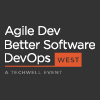 |
Predictive Test Planning to Improve System Quality
Slideshow
Penny McVay shares how her team approached improving the quality of a large policy-writing application for a global insurance carrier. The application has many pieces and parts, thousands of lines of code are changed monthly, and the business depends on a stable application. To mitigate...
|
Penny McVay
|
 |
Zorro Circles: Retrospectives for Excellence
Slideshow
Have you wondered how to progressively harness your agile team’s energy, focus on important goals, and improve outcomes? Woody Zuill said, “If you could adopt only one agile practice, then let it be retrospectives. Everything else will follow.” Retrospectives help individuals and teams...
|
Aakash Srinivasan and Vivek Angiras
|
 |
A Case Study in Metrics-Driven DevOps
Slideshow
It seems impossible for a DevOps team to even attempt planning its work. The team deals with customers’ never-ending requests and constantly-changing priorities. And don’t forget those unfriendly infrastructure errors that always seem to show up at the worst possible time. Best to live...
|
Ben Vining
|
 |
Slay the Dragons of Agile Measurement
Slideshow
Some consider measurement in agile development destructive—or at the very least useless. Larry Maccherone disagrees and offers eight tools to slay the dragons of agile measurement. The #1 Dragon slayer—Use measurement for feedback rather than as a lever. What's the difference? Feedback is...
|
Larry Maccherone
|
 |
Five Critical Elements for Successful Agile Data Management
Slideshow
In the past few years we’ve used cloud technologies to improve pre-production flexibility and solve many problems that previously prevented us from delivering high quality apps to production. However, one problem consistently prevents full test coverage prior to deployment—the lack of...
|
Robert Kelman
|
 |
Playwriting, Imagination, and Agile Software Development … Oh My!
Slideshow
Agile practitioners are constantly striving to improve their processes and delivery to gain a competitive edge. To become a cross-functional T-shaped rock star, you have to be open to learning from other disciplines and adapting quickly. Tania Katan knows a little about crossing...
|
Tania Katan
|
 |
Use Feature Flags for Clean Deployments
Slideshow
Software teams want to move faster and deliver features to end users sooner. Continuous delivery and DevOps promise to deploy quickly. However, pushing faster and deploying more often increase the risk of breaking—and subsequent downtime. Edith Harbaugh finds that a feature flagging system...
|
Edith Harbaugh
|
 |
Continuous Integration as a Development Team’s Way of Life
Slideshow
Continuous integration (CI) is a buzzword in software development today. We know it means “run lots of builds,” but having a continuous integration pipeline opens up opportunities well beyond making sure your team's code compiles. What if this pipeline could improve everything from the...
|
Melissa Benua
|
 |
Implementing Agile in an FDA Regulated Environment
Slideshow
Developing medical devices that are subject to FDA approval has traditionally followed the waterfall methodology, largely due to the structure of the regulations that govern development practices. But we know from myriad case studies in different industries that agile methodologies are far...
|
Neal Herman
|
 |
How Far Can You Go with Agile for Embedded Software?
Slideshow
With the proliferation of IoT and consumer demand for smarter homes, appliances, automobiles, and wearables, many traditional product-based manufacturing companies are now becoming embedded software companies. This means that the design and manufacturing of physical products is becoming...
|
Anders Wallgren
|

